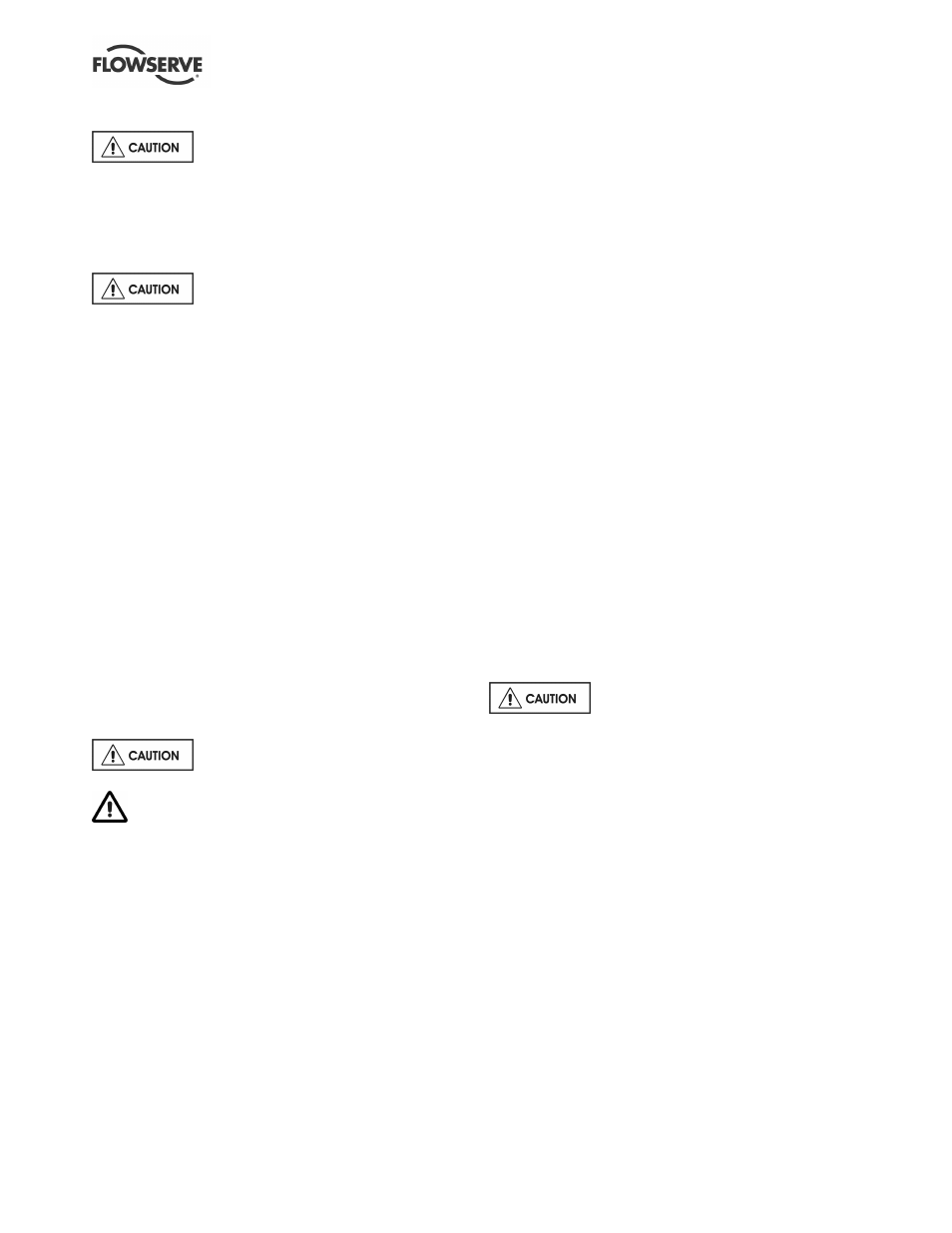Flowserve CPXM User Manual
Page 13

CPXM and CPXRM USER INSTRUCTIONS ENGLISH 71569101 10-08
Page 13 of 32
flowserve.com
4.5 Piping
Protective covers are fitted to the pipe
connections to prevent foreign bodies entering during
transportation and installation. Ensure that these
covers are removed from the pump before connecting
any pipes.
4.5.1 Suction and discharge pipework
Never use pump as a support for
piping.
Take into account the available NPSH which must be
higher than the required NPSH of the pump.
In order to minimize friction losses and hydraulic
noise in the pipework it is good practice to choose
pipework that is one or two sizes larger than the
pump suction and discharge. Typically main
pipework velocities should not exceed 2 m/s (6 ft/sec)
suction and 3 m/s (9 ft/sec) on the discharge.
Maximum forces and moments allowed on the pump
flanges vary with the pump size and type. To
minimize these forces and moments that may, if
excessive, cause misalignment, hot bearings, worn
couplings, vibration and the possible failure of the
pump casing, the following points should be strictly
followed:
•
Prevent excessive external pipe load
•
Never draw piping into place by applying force to
pump flange connections
•
Do not mount expansion joints so that their force,
due to internal pressure, acts on the pump flange
Ensure piping and fittings are flushed
before use.
Ensure piping for hazardous liquids is arranged
to allow pump flushing before removal of the pump.
4.5.2 Suction piping
a) The inlet pipe should be one or two sizes larger
than the pump inlet bore and pipe bends should
be as large a radius as possible.
b) On suction lift the piping should be inclined up
towards the pump inlet with eccentric reducers
incorporated to prevent air locks.
c) On positive suction, the inlet piping must have a
constant fall towards the pump.
d) The pipe next to the pump should be the same
diameter as the pump suction and have a
minimum of two pipe diameters of straight section
between the elbow and the pump inlet flange.
Where the NPSH margin is not large, it is
recommended that the pipe straight is 5 to 10
pipe diameter. (See section 10.3, Reference 1.)
Inlet strainers, when used, should have a net
'free area' of at least three times the inlet pipe
area.
e) Fitting isolation and non-return valves will allow
easier maintenance.
f) Never throttle pump on suction side and never
place a valve directly on the pump inlet nozzle.
4.5.3 Discharge piping
a) A non-return valve should be located in the
discharge pipework to protect the pump from
excessive back pressure and hence reverse
rotation when the unit is stopped.
b) Fitting an isolation valve will allow easier
maintenance.
4.5.4 Flange loads
The permissible flange loading is dependent on a
number of factors such as dimensions, flange rating,
pressure, temperature, material, pump configuration,
etc. The recommendations contained in the section on
pipework connections should be followed to eliminate
these loads.
When requested the permissible flange loading will
have been supplied separately to the purchaser and
should be obtained and retained with this manual. If in
doubt contact Flowserve for information.
4.5.5 Auxiliary piping
The connections that are to be piped
up will have been fitted with protective metal or
plastic plugs which will need to be removed.
4.5.5.1 Pumps fitted with mechanical seals
The conical design of the single internal seal housing
provides excellent liquid circulation around the seal and
will not normally require a separate flush.
Single seals requiring re-circulation will normally be
provided with the auxiliary piping from pump casing
already fitted.
Flowserve seal connections are designated as
follows:
Q
- quench
F
- flush
D
- drain outlet
BI - barrier fluid in (double seals)
BO - barrier fluid out (double seals)
H
- heating jacket
